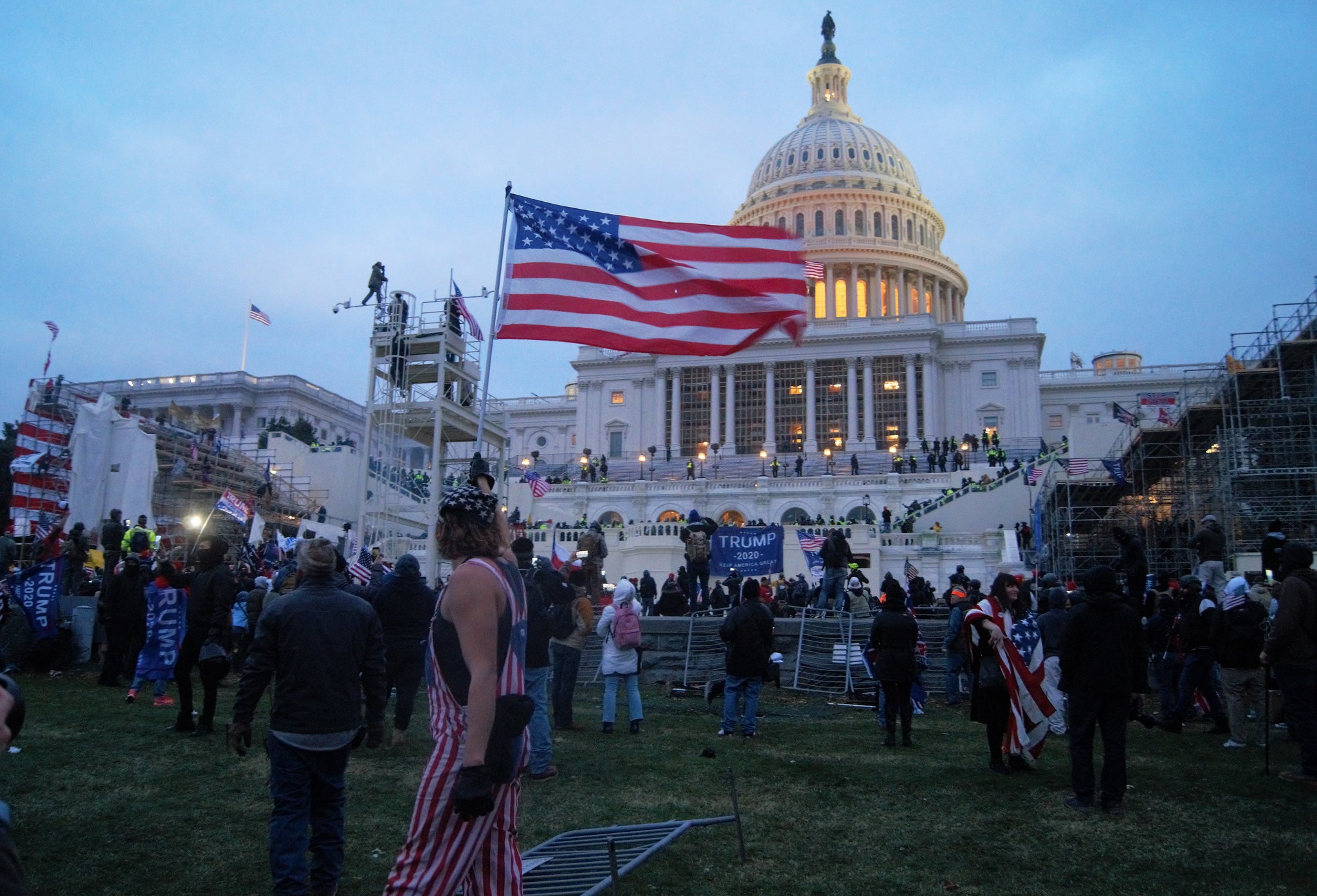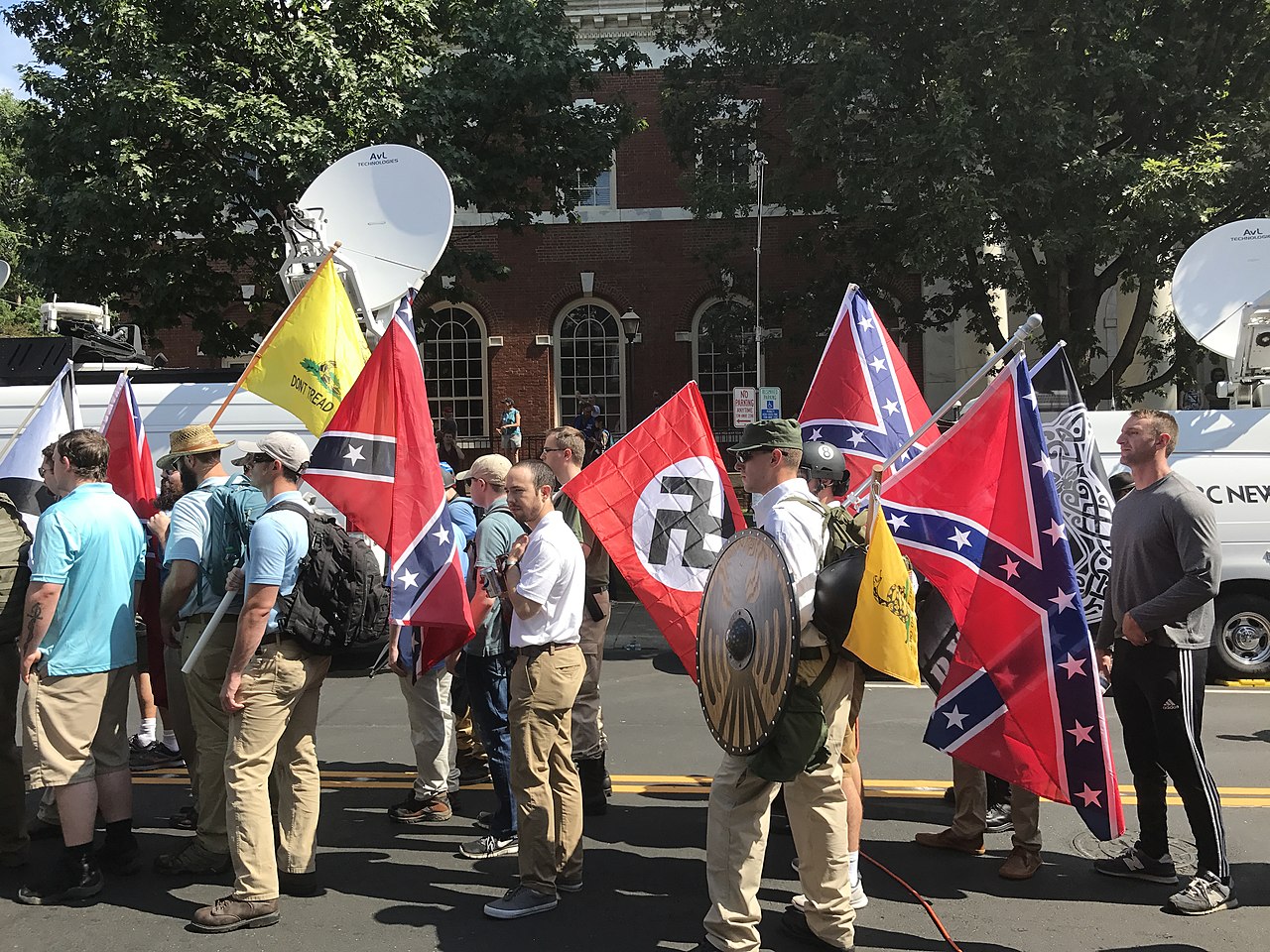Adding Domestic Extremists to the No-Fly List
What is the legal foundation of the No-Fly List and how does it fit into the government's arsenal?

Published by The Lawfare Institute
in Cooperation With

Introduction
Recent reports have indicated that the Biden administration is contemplating adding domestic extremists—including some of the Jan. 6 riot participants—to the terrorism No Fly List. These stories come in the aftermath of the attack on the Capitol and in the wake of numerous calls by politicians and airline workers for the federal government to reorient the No Fly List toward domestic extremism. But the picture isn’t fully clear. Media outlets have run conflicting accounts of how feasible such a move would be in the absence of broader domestic terrorism legislation. Adding to the confusion surrounding the potential expansion of the No Fly List, bystander videos of apparent Jan. 6 participants being turned away from flights went viral in the days after the attack on the Capitol. (It later came out that they were denied access not because of their presence on the No Fly List but, rather, for unruly behavior or for refusing to wear masks.)
The No Fly List is a high-profile and powerful anti-terror tool in the government’s arsenal, but how it works is often poorly understood—in no small part because the government does not make the list nor its processes for adding, maintaining, or removing individuals publicly available, despite the list’s nonclassified status. Here we will provide a high-level primer on the list’s legal foundation, exactly what the list is and how it works, available measures of redress for people who believe they should not be on the list, and the feasibility of adding suspected domestic extremists. We offer one overarching caveat to the information we discuss here: Much about the No Fly List has not been publicly disclosed, and its workings are subject to change largely at the discretion of the executive branch.
The List’s Legal Foundation
A very limited version of the No Fly List existed prior to the Sept. 11, 2001, terrorist attacks. At the time of the attacks, the list had just 16 names on it. In the aftermath of 9/11, the government expanded the list dramatically and created the broader terrorist databases from which the No Fly List is now curated. Since then, the No Fly List has become a subset of a much larger list, the Terrorism Screening Database (TSDB), which is maintained by the FBI’s Terrorist Screening Center (TSC).
The legal foundation of the TSDB and the screening lists that derive from it traces back to the Sept. 16, 2003, Homeland Security Presidential Directive 6 (HSPD-6), which authorized the creation of an organization that would be responsible for consolidation of all information about individuals known or suspected to be engaged in terrorist activity. A year later, Executive Order 13354 created the National Counterterrorism Center (NCTC) to take on that responsibility. The NCTC was codified shortly thereafter in § 1021 of the Intelligence Reform and Terrorism Prevention Act of 2004 (what is now 50 U.S.C. § 3056). Following the NCTC’s establishment, a memorandum of understanding titled “Integration and Use of Screening Information to Protect Against Terrorism” created the TSC. Under these authorities and “consistent with the Constitution and other applicable federal laws,” the TSC develops and maintains the TSDB.
In 2008, a Homeland Security Presidential Directive (HSPD-24) directed agencies to use all biometric information associated with persons nominated to the TSC for the TSDB and established “articulable and reasonable basis for suspicion” as the threshold for inclusion in the TSDB.
What Exactly Is the No Fly List, and How Does it Work?
First, it is important to emphasize that the No Fly List is maintained by the government. This might seem obvious, but airlines also maintain their own lists of banned passengers—typically because of prior unruly or disruptive behavior on flights—and those lists have grown substantially since the start of 2021 due to a combination of behavior and security concerns related to mask mandates and the Jan. 6 riot. Based on data reported by the major airlines that release this information, roughly 3,000 people are on at least one airline list.
Per the memorandum of understanding, the TSC serves as the clearinghouse for information gathered by the FBI, the Department of State, the Department of Homeland Security (DHS), the intelligence community, and other federal and state law enforcement agencies for the TSDB. The TSDB serves as a broader terrorist watchlist for the federal government and contains identifying information of “known or suspected terrorists.” Analysts and agents nominate individuals for inclusion in the TSDB and then those nominations are vetted by analysts at the NCTC or the FBI before being verified by TSC staffers.
The TSC accepts a nomination when “there is reasonable suspicion to believe that the person is a known or suspected terrorist.” Per a 2013 NCTC manual providing guidance on the watchlisting process, reasonable suspicion requires [pg. 34] that the nominator must rely on “articulable intelligence” and “rational inferences from those facts” that, together, “reasonably warrant[] a determination that an individual is known or suspected to be or has been knowingly engaged in conduct constitution, in preparation for, in aid of, or related to terrorism and/or terrorist activities.” The TSC looks at a variety of factors when considering whether to add a nominated individual to the TSDB, including the person’s “travel history, associates, business associations, international connections, financial transactions, and ethnic or religious affiliations.” Basing a nomination “solely” on First Amendment activities—like speech or protest—or “mere guess or hunches” is “prohibited” [pgs. 34-35]. A nomination satisfies the reasonable suspicion prong and must also include “sufficient identifiers”—at the very least a last name and another piece of information, like a first name or date of birth—so that the airlines and the Transportation Security Administration (TSA) can determine whether to allow the individual to board. The TSDB contains only an individual’s identifying information, not any classified intelligence or other underlying facts that warranted the individual’s nomination.
Most nominations to the TSDB are accepted. From fiscal 2009 to fiscal 2013, agencies forwarded 1,558,710 nominations, of which only 14,183 were rejected—a rejection rate of 0.9 percent. Filings in a recent case heard by the U.S. Court of Appeals for the Fourth Circuit indicate that the rejection rate has remained relatively consistent since 2013.
The TSC frequently provides curated portions of the TSDB to five federal agencies, including TSA, which is a branch of DHS. Using data pulled from the TSDB, TSA runs three different, related lists: the No Fly List, the Selectee List and the Expanded Selectee List. Individuals placed on any of those lists are subject to heightened scrutiny while traveling. This diagram displays the flow of information from agencies to the TSDB and then to TSA’s three lists.
The largest and most well known of the three sublists is the No Fly List. Much smaller than the TSDB—it contained 64,000 people as of 2014, compared to 800,000 in the TSDB—the No Fly List has ostensibly stricter criteria for inclusion than its larger counterpart and the Expanded Selectee List, at least according to DHS. As its name suggests, anyone on the No Fly List is barred from boarding a commercial aircraft that “traverses U.S. airspace.” A 2013 NCTC document lays out [pg. 51] the criteria for inclusion on the No Fly List: An individual “regardless of citizenship” must represent a threat of committing an act of international terrorism (as defined by 18 U.S.C. § 2331(1)) or domestic terrorism (as defined by 18 U.S.C. § 2331(5)) against the U.S., federal government facilities overseas, or any aircraft or passenger on one; or be “a threat of engaging in or conducting a violent act of terrorism and who is operationally capable of doing so.” For purposes of the list, an act of terrorism is defined as any violent act prohibited by 18 U.S.C. § 2331 or 18 U.S.C. § 2332b.
When it comes to potential domestic extremists being placed on the No Fly List, these criteria are quite broad. As we have discussed elsewhere on Lawfare, the definition of domestic terrorism under § 2331(5) is expansive: acts within the U.S. that are dangerous to human life, violate the laws of the U.S. or a state, and “appear to be intended—(i) to intimidate or coerce a civilian population; (ii) to influence the policy of a government by intimidation or cercion; or (iii) to affect the conduct of a government by mass destruction, assassination, or kidnapping[.]” For the purposes of the No Fly List, any person who poses a threat of violating any law, state or federal, with the purpose of intimidating civilians or coercing a government can be barred from commercial flight. As for the second prong, § 2332b(g)(5)(B) bans more than 50 specific acts, ranging from extremely serious conduct like the use of an improvised explosive device to property crime, like the destruction of federal property under § 1361 or arson of property used in interstate commerce under § 844(i). For example, multiple defendants are facing § 1361 charges for their participation in forcibly storming the Capitol on Jan. 6, and dozens of defendants are facing § 844(i) charges for destroying property during Black Lives Matter protests in the summer of 2020. These defendants, or anyone else whom federal authorities conclude poses a threat of such conduct or other proscribed conduct under § 2332b(g)(5)(B), could be placed on the No Fly List.
As discussed above, the 2013 NCTC guidance document [pg. 53] explains that an individual whom federal authorities deem to pose a “threat of engaging in or conducting a violent act of terrorism” and is “operationally capable” may be placed on the No Fly List. The guidance does not further define what it means to pose a “threat of engaging in or conducting a violent act of terrorism.” As for the second prong, potential indicators of being “operationally capable” include “terrorist training,” indicating an “intent to participate in planning/conducting an attack,” “express[ing] desire to martyr [one]self,” being in repeat contact with a “known terrorist facilitator,” “planning an attack either alone or as part of a group,” or being “associated with a terrorist group/cell and accumulating weapons/explosives.”
Nominating agencies must ensure that their No Fly List nominations satisfy one of these criteria, and the Watchlisting Guidance requires that the agencies periodically review nominations of U.S. persons to the TSDB.
Individuals who do not meet the criteria necessary to be placed on the No Fly List may still be placed on the Selectee List, which requires that selected individuals undergo extra security measures before being allowed to board any commercial aircraft flying within U.S. airspace. Criteria for the Selectee List are similarly strict to those of the No Fly List, though the former list targets a different group of people. Any person who does not meet the No Fly List criteria, “regardless of citizenship,” and is either a member of a foreign or domestic terrorist organization or is associated with terrorist activity (as defined by 8 U.S.C. § 1182(a)(3)(B)) is eligible to be placed on the Selectee List. It is important to note that the term “domestic terrorist organization” has no legal meaning, so it’s up to the nominating agency and the TSC to decide whether a particular group meets the bar for “domestic terrorist organization.” Unlike foreign terrorist organizations, which are formally designated as such by the Department of State, there is no formal process by which the federal government can legally designate a group as a domestic terrorist organization.
The Expanded Selectee List was created after Umar Farouk Abdulmutallab (commonly known as the Underwear Bomber) tried but failed to detonate explosives hidden in his clothes while on a Christmas Day flight to Detroit in 2009. It includes [pg. 55] TSDB records of anyone who does not meet the No Fly List or Selectee List criteria but about whom the government nevertheless has reasonable suspicion that they are involved in some sort of terrorist activity. It appears that the Expanded Selectee List is used only in times of particular emergency, but the government has not publicly explained how it uses this information or what qualifies as an emergency. Like the Selectee List, individuals on the Expanded Selectee List are subject to enhanced security screening before being allowed to board a commercial aircraft. In recent court filings, the government has said the Selectee List requires “additional substantive derogatory criteria,’’ while the Expanded Selectee List does not. Essentially, the government uses the Expanded Selectee List as a double check of everyone currently in the TSDB whose full name and date of birth are known but who is on neither the No Fly List nor the Selectee List.
In practice, TSA compares records from the No Fly List and the Selectee List (and occasionally the Expanded Select List) to passenger records for upcoming flights through a program called Secure Flight. TSA also shares these records with airline companies on a daily basis. When passengers who are included on one of those lists arrive at the airport, they are either turned away or subjected to extra security screening, depending on their categorization.
Exact numbers for the current iterations of the No Fly List, the Selectee lists, or the TSDB are not publicly available. But as of 2014, more than 40 percent of those in the TSDB and an unknown number who may also have been on the No Fly or Selectee lists had no known affiliations with terrorist organizations. Recent court filings indicate that there are currently about 1,160,000 individuals in the TSDB, of whom only about 4,600 are U.S. citizens. Moreover, the No Fly List has generated criticism over the years for misspelled names or other mistakes that have inadvertently landed people on the list rather than the intended targets. The erroneous additions include an infant, then-Sen. Ted Kennedy, then-Rep. John Lewis, and two journalists.
Some critics have also noted that placement on the No Fly List has allegedly been used by federal law enforcement to attempt to coerce Muslims in America to become government informants or punish them for refusing to do so. In December 2020, the Supreme Court ruled unanimously in Tanzin v. Tanvir that three Muslim men who refused to become informants could sue for damages, under the Religious Freedom Restoration Act (RFRA), against the FBI agents who placed them on the No-Fly list in retaliation.
In addition to being criticized by lawmakers and civil liberties groups, the No Fly List has come under criticism from within the federal government. A 2007 report from the Office of the Inspector General for the Justice Department criticized the TSC’s quality assurance process for ensuring accuracy of its watchlist database after finding that 38 percent of records audited contained mistakes or inconsistencies. Five years later, a Government Accountability Office (GAO) report explained that nominating agencies were concerned about their ability to analyze accurately the significant increase in nomination information; federal agencies had expanded the TSDB and No Fly List again after the attempted Christmas Day airplane bombing, more than doubling the number of individuals on the No Fly List. The GAO report also noted that no agency had assessed the “overall levels of misidentifications” or whether “watchlist-related screening or vetting is achieving intended results from a policy perspective.”
What Options Are Available to People Who Have Been Added to the List?
As explained above, numerous people have mistakenly ended up on the No Fly List, the Selectee List or the Expanded Selectee List. Even some individuals who are correctly identified on these lists might have been added based on incomplete or inaccurate information about the alleged threat they pose. What options do these people have to get themselves removed? Upon being denied boarding or being subjected to additional screening, individuals can file a complaint with DHS’s Traveler Redress Inquiry Program (DHS TRIP). DHS sends the complaints to the TSC. At the outset, it may be difficult to determine if a person is on one of these lists, as “the U.S. government’s general policy is to neither confirm nor deny a person’s watchlist status, except in very limited circumstances involving the No Fly List.” For U.S. citizens and lawful permanent residents, DHS TRIP will inform them of their status on the No Fly List and provide an opportunity to receive additional information, including the general criteria that resulted in their placement on the list and possibly a summary of the reasons for their inclusion. The government does not share any of the evidence it relied on, nor does it provide an opportunity for hearings at which people could contest their placement on the list. Upon receipt of this additional information, U.S. citizens and lawful permanent residents can submit a response that includes information and documents demonstrating why they should not be on the list, which the government reviews before informing the complainant of its final decision. DHS TRIP does not inform non-U.S. citizens or lawful permanent residents of their status on the No Fly List nor provide them with the above redress process.
Individuals on any of these lists—even if they do not have official confirmation that they are in fact on a particular list—can challenge that status in court. When hearing challenges to the No Fly List and the TSDB, however, courts have sided with the government and upheld these programs as constitutional. In 2019, the U.S. Court of Appeals for the Ninth Circuit held in Kashem v. Barr that the No Fly List criteria are not unconstitutionally vague and that the procedures available to the plaintiffs to challenge their placement on the list satisfied due process. The Sixth Circuit in Beydoun v. Sessions and the Tenth Circuit in Abdi v. Wray have both recently rejected plaintiffs’ claims of due process violations based on their inclusion on the Selectee List. And just last month, the Fourth Circuit in Kable v. Elhady held that the procedures for inclusion in the TSDB do not violate due process, overturning a lower court decision that held otherwise. Notably absent from these cases are First Amendment as-applied challenges to the criteria for inclusion on the No Fly and Selectee lists or the TSDB, likely because the plaintiffs do not know and cannot determine whether their speech played a role in their inclusion in these lists or databases.
Can the Federal Government Add Domestic Extremists to the No Fly List?
Yes, the federal government’s existing authorities empower it to include known or suspected domestic terrorists on the No Fly List. The vast majority of individuals on the No Fly List over the past two decades have been foreign nationals, but the list has included U.S. citizens and legal permanent residents for years. While U.S. persons receive heightened review by nominating agencies before being added to the TSDB, the standard of evidence is the same as for non-U.S. persons: reasonable suspicion [p. 18]. Since 9/11, the federal government’s counterterrorism apparatus has focused primarily on international rather than domestic terrorism, so the TSDB, and consequently the No Fly List, largely comprise individuals with known or suspected links to international terrorism. Furthermore, the NCTC’s mission has historically focused on integrating intelligence from other agencies pertaining to international terrorism, although the NCTC is authorized to receive intelligence on exclusively domestic terrorism as well. It’s possible that the rise of domestic terrorism in the past few years has led to a greater number of known or suspected domestic terrorists ending up on the list, but there’s no clear answer. Regardless, none of these guidelines or directives prevents the federal government from adding domestic terrorists to the No Fly List, including those involved in the Capitol riot whose conduct meets § 2331(5)’s definition of domestic terrorism.
Despite the prohibition on adding a candidate to the TSDB or the No Fly List based “solely” on First Amendment activity, the broad (and at times vague) placement criteria create the danger that First Amendment activity will play a substantial role in someone’s inclusion in the TSDB. As discussed above, the government may place individuals on the No Fly List if it concludes they are “a threat of engaging in or conducting a violent act of terrorism” and are operationally capable. Individuals could be deemed “operationally capable” for expressing an “intent to participate in planning/conducting an attack,” indicating a desire to martyr themselves, or associating with a known terrorist group while purchasing weapons [p. 52]. Certain speech that authorities might construe as expressing an intent to plan or an intent to conduct an attack could fall well within the First Amendment’s ambit, as could various forms of association with a domestic terrorist group. As for “accumulating weapons/explosives,” U.S. persons are obviously allowed to buy a wide range of weapons as long as they do so lawfully. The bottom line is that the placement criteria are open ended and flexible to the point that First Amendment activity could prominently factor into someone being placed in the TSDB and subsequently on the No Fly List.
Of course, relatively few American citizens are currently on the No Fly List and, even if the federal government wields its authorities to flag more Americans in an effort to combat domestic extremism, it’s certainly possible that no civil liberties will be violated in the process. In fact, there are convincing reasons why the federal government might not take a maximalist approach to placing potential domestic extremists on the No Fly List, especially when such placements might be based largely on First Amendment-protected activity. First, and most importantly, Biden administration officials have acknowledged the danger of conflating First Amendment-protected activity with extremist conduct and may be reluctant to do so in relation to adding people to the No Fly List, even as they increasingly crack down on domestic extremism. Second, even if the government were inclined to place U.S. citizens on the No Fly List for First Amendment-adjacent activity, it might be reluctant to do so to the fullest extent out of fear of litigation. Because U.S. citizens can contest their placement on the list and review a summary of the government’s reasons for their designation, they could bring federal suits alleging violations of their First Amendment rights. If lower courts, and potentially the Supreme Court, were sympathetic to those arguments, the government could find its powers curtailed significantly through adverse decisions. Finally, even if people placed on the No Fly List lost their court battles, they might be able to generate enough publicity that would convince lawmakers and the public to call for limiting the government’s authority in this area. The intersection of national security and political expression is a controversial and highly charged subject; for both practical and normative reasons, the federal government might be wary of fanning the flames of that debate through aggressive use of the No Fly List.
All that being said, it is not difficult to imagine scenarios in which U.S. persons could be placed on the No Fly List according to a nomination process that, while following the requisite legal guidelines, still relies substantially on constitutionally protected activity. For example, citizens can be deemed operationally capable by declaring a desire to martyr [pg. 53] themselves. If the government concludes that they could pose a threat of a violent act of terrorism, which includes property crimes, then they may be placed on the list. Alternatively, imagine a citizen who is loosely connected with a group involved in the Jan. 6 riot—like the Oath Keepers or the Proud Boys. If that person publicly or privately indicates a desire to similarly rebel against the government, perhaps by rioting at a state capitol building or other government target, and then legally buys a weapon, the individual will probably have satisfied the criteria necessary for inclusion on the No Fly List. Even the additional protections afforded to U.S. persons in the screening process discussed above may not prevent someone from being added for meeting the criteria laid out by the guidance. The opacity of the nomination process means that it is difficult to tell exactly what conduct or related speech will trigger placement on the No Fly List. The U.S. government could adhere to the bounds of the existing legal framework even as it tiptoes to the edge of First Amendment (or other constitutional) protections by placing someone on the list.






